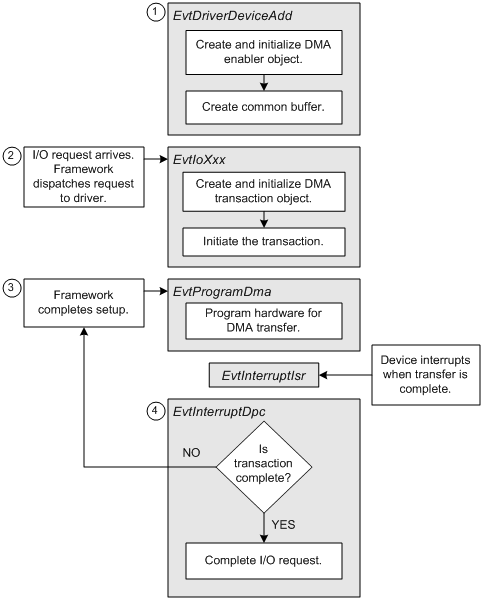Handling I/O Requests in a KMDF Driver for a Bus-Master DMA Device
[Applies to KMDF only]
This topics in this section describe how a KMDF driver for a bus-master DMA device processes an I/O request. If you are writing a KMDF driver that implements system-mode DMA, see Supporting System-Mode DMA.
Handling I/O requests in a KMDF driver for a bus-master DMA device requires code in several of the driver’s event callback functions, as shown in the following figure:

As shown above, DMA-related processing takes place in four phases:
Your driver's EvtDriverDeviceAdd or EvtDevicePrepareHardware callback function must enable DMA transactions for the device, so that your driver can use the framework's DMA capabilities. The same callback function must also create a common buffer if your device and driver require access to a shared memory buffer.
When your driver receives an I/O request that requires the device to perform a DMA operation, one of the driver's request handlers must create and initialize a new DMA transaction. (Note that if your driver reuses DMA transaction objects, your driver's EvtDriverDeviceAdd callback function can create the transaction objects.) Then, the request handler must initiate the DMA transaction so that the framework can begin breaking the transaction into smaller DMA transfers, if necessary, and call the driver's EvtProgramDma callback function.
Your driver's EvtProgramDma callback function programs the DMA hardware for a single DMA transfer and enables device interrupts.
When the device interrupts, the framework calls your driver's EvtInterruptIsr callback function, which saves volatile device information and schedules execution of the driver's EvtInterruptDpc callback function.
Your driver's EvtInterruptDpc callback function completes each DMA transfer after the hardware finishes processing it. After a DMA transaction's final transfer is complete, the EvtInterruptDpc callback function completes the DMA transaction.
Your driver might reuse its DMA transaction objects to ensure that they can operate when memory resources are low.
Your driver can provide a set of callback functions that handle DMA-specific power management operations.
Some drivers use common buffers that both a device and the driver can access.